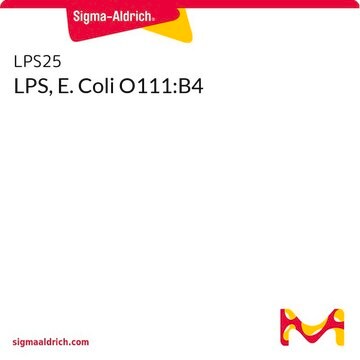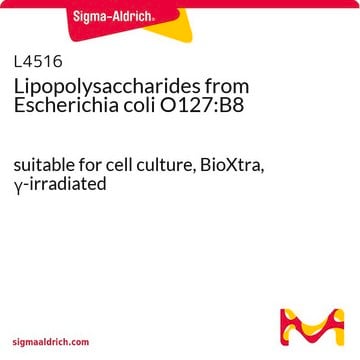If this product has an expiration or retest date, it will be shown on the Certificate of Analysis (COA, CofA). If there is no retest or expiration date listed on the product's COA, we do not have suitable stability data to determine a shelf life. For these products, the only date on the COA will be the release date; a retest, expiration, or use-by-date will not be displayed.
For all products, we recommend handling per defined conditions as printed in our product literature and website product descriptions. We recommend that products should be routinely inspected by customers to ensure they perform as expected.
For products without retest or expiration dates, our standard warranty of 1 year from the date of shipment is applicable.
For more information, please refer to the Product Dating Information document: https://www.sigmaaldrich.com/deepweb/assets/sigmaaldrich/marketing/global/documents/449/386/product-dating-information-mk.pdf
L5293
Lipopolysaccharides from Escherichia coli O111:B4
Ready Made solution, 1 mg/mL
Sinónimos:
LPS
Seleccione un Tamaño
314,00 €
Seleccione un Tamaño
About This Item
314,00 €
Productos recomendados
origen biológico
Escherichia coli (O111:B4)
Nivel de calidad
Formulario
aqueous solution
concentración
1 mg/mL
color
colorless to faint yellow
solubilidad
water: soluble
Condiciones de envío
wet ice
temp. de almacenamiento
2-8°C
¿Está buscando productos similares? Visita Guía de comparación de productos
Aplicación
Acciones bioquímicas o fisiológicas
Nota de preparación
Otras notas
Producto relacionado
Código de clase de almacenamiento
12 - Non Combustible Liquids
Clase de riesgo para el agua (WGK)
WGK 1
Punto de inflamabilidad (°F)
Not applicable
Punto de inflamabilidad (°C)
Not applicable
Equipo de protección personal
Eyeshields, Gloves, multi-purpose combination respirator cartridge (US)
Elija entre una de las versiones más recientes:
Certificados de análisis (COA)
¿No ve la versión correcta?
Si necesita una versión concreta, puede buscar un certificado específico por el número de lote.
¿Ya tiene este producto?
Encuentre la documentación para los productos que ha comprado recientemente en la Biblioteca de documentos.
Los clientes también vieron
Artículos
Explore the structure, function, and diverse applications of Lipopolysaccharides. Discover their role in bacteria, serological specificity, and research potential.
Contenido relacionado
Lipopolysaccharide (LPS) is a major component of Gram-negative bacteria, important for microbiological research.
-
How can I determine the shelf life / expiration / retest date of this product?
1 respuesta-
¿Le ha resultado útil?
-
-
How is shipping temperature determined? And how is it related to the product storage temperature?
1 respuesta-
Products may be shipped at a different temperature than the recommended long-term storage temperature. If the product quality is sensitive to short-term exposure to conditions other than the recommended long-term storage, it will be shipped on wet or dry-ice. If the product quality is NOT affected by short-term exposure to conditions other than the recommended long-term storage, it will be shipped at ambient temperature. As shipping routes are configured for minimum transit times, shipping at ambient temperature helps control shipping costs for our customers. For more information, please refer to the Storage and Transport Conditions document: https://www.sigmaaldrich.com/deepweb/assets/sigmaaldrich/marketing/global/documents/316/622/storage-transport-conditions-mk.pdf
¿Le ha resultado útil?
-
-
What is recommended for the storage of longer duration once opened? Is it better to keep at 2°C-8°C for 1-2 years or to freeze it (-80°C or -20°C) and thaw it gently when needed?
1 respuesta-
This product is stable at 2-8°C at least until the assigned retest date, provided that no contaminants have been introduced. The recommended retest date is lot specific and reported in the product Certificate of Analysis. The stability of the product in dilute form or beyond the assigned retest date has not been determined. However, LPS products prepared from the powder form may be stored in 1 mg/mL aliquots for up to 2 years at -20°C. The storage of solutions at -80°C has not been determined. Please see the link below to review additional information regarding the stability and preparation of Lipopolysaccharides:
https://www.sigmaaldrich.com/technical-documents/protocol/clinical-testing-and-diagnostics-manufacturing/bacteriology/lipopolysaccharides¿Le ha resultado útil?
-
-
What solvent is the product L5293-2ML dissolved in?
1 respuesta-
The solvent information for this product is proprietary, but it is acknowledged to contain water, while the remaining components remain undisclosed.
¿Le ha resultado útil?
-
-
Bonjour, Comment ce LPS a t'il été extrait / Purifié ?
1 respuesta-
This product is a sterile filtered solution. The extraction method for this material is considered proprietary, however it is chromatographically purified.
¿Le ha resultado útil?
-
Filtros activos
Nuestro equipo de científicos tiene experiencia en todas las áreas de investigación: Ciencias de la vida, Ciencia de los materiales, Síntesis química, Cromatografía, Analítica y muchas otras.
Póngase en contacto con el Servicio técnico




